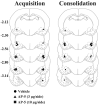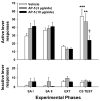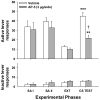NMDA receptor blockade in the basolateral amygdala disrupts consolidation of stimulus-reward memory and extinction learning during reinstatement of cocaine-seeking in an animal model of relapse
- PMID: 17613253
- PMCID: PMC2080837
- DOI: 10.1016/j.nlm.2007.05.006
NMDA receptor blockade in the basolateral amygdala disrupts consolidation of stimulus-reward memory and extinction learning during reinstatement of cocaine-seeking in an animal model of relapse
Abstract
Previous research from our laboratory has implicated the basolateral amygdala (BLA) complex in the acquisition and consolidation of cue-cocaine associations, as well as extinction learning, which may regulate the long-lasting control of conditioned stimuli (CS) over drug-seeking behavior. Given the well established role of NMDA glutamate receptor activation in other forms of amygdalar-based learning, we predicted that BLA-mediated drug-cue associative learning would be NMDA receptor dependent. To test this hypothesis, male Sprague-Dawley rats self-administered i.v. cocaine (0.6 mg/kg/infusion) in the absence of explicit CS pairings (2-h sessions, 5 days), followed by a single 1-h classical conditioning (CC) session, during which they received passive infusions of cocaine discretely paired with a light+tone stimulus complex. Following additional cocaine self-administration sessions in the absence of the CS (2-h sessions, 5 days) and extinction training sessions (no cocaine or CS presentation, 2-h sessions, 7 days), the ability of the CS to reinstate cocaine-seeking on three test days was assessed. Rats received bilateral intra-BLA infusions (0.5 microl/hemisphere) of vehicle or the selective NMDA receptor antagonist, 2-amino-5-phosphonovalerate (AP-5), immediately prior to the CC session (acquisition), immediately following the CC session (consolidation), or immediately following reinstatement testing (consolidation of conditioned-cued extinction learning). AP-5 administered before or after CC attenuated subsequent CS-induced reinstatement, whereas AP-5 administered immediately following the first two reinstatement tests impaired the extinction of cocaine-seeking behavior. These results suggest that NMDA receptor-mediated mechanisms within the BLA play a crucial role in the consolidation of drug-CS associations into long-term memories that, in turn, drive cocaine-seeking during relapse.
Figures





Similar articles
-
The role of the basolateral amygdala in stimulus-reward memory and extinction memory consolidation and in subsequent conditioned cued reinstatement of cocaine seeking.Eur J Neurosci. 2006 May;23(10):2809-13. doi: 10.1111/j.1460-9568.2006.04806.x. Eur J Neurosci. 2006. PMID: 16817884
-
Dopamine, but not glutamate, receptor blockade in the basolateral amygdala attenuates conditioned reward in a rat model of relapse to cocaine-seeking behavior.Psychopharmacology (Berl). 2001 Mar;154(3):301-10. doi: 10.1007/s002130000636. Psychopharmacology (Berl). 2001. PMID: 11351937
-
Reversible inactivation of the basolateral amygdala, but not the dorsolateral caudate putamen, attenuates consolidation of cocaine-cue associative learning in a reinstatement model of drug-seeking.Eur J Neurosci. 2010 Sep;32(6):1024-9. doi: 10.1111/j.1460-9568.2010.07394.x. Epub 2010 Aug 26. Eur J Neurosci. 2010. PMID: 20796021 Free PMC article.
-
Neural substrates of cocaine-cue associations that trigger relapse.Eur J Pharmacol. 2005 Dec 5;526(1-3):140-6. doi: 10.1016/j.ejphar.2005.09.034. Epub 2005 Oct 25. Eur J Pharmacol. 2005. PMID: 16253228 Review.
-
Drug addiction, relapse, and the amygdala.Ann N Y Acad Sci. 2003 Apr;985:294-307. doi: 10.1111/j.1749-6632.2003.tb07089.x. Ann N Y Acad Sci. 2003. PMID: 12724166 Review.
Cited by
-
Extinction of aversive memories associated with morphine withdrawal requires ERK-mediated epigenetic regulation of brain-derived neurotrophic factor transcription in the rat ventromedial prefrontal cortex.J Neurosci. 2012 Oct 3;32(40):13763-75. doi: 10.1523/JNEUROSCI.1991-12.2012. J Neurosci. 2012. PMID: 23035088 Free PMC article.
-
Metabotropic group II glutamate receptors mediate cue-triggered increases in reward-seeking behaviour.Psychopharmacology (Berl). 2023 Mar;240(3):515-529. doi: 10.1007/s00213-022-06101-z. Epub 2022 Mar 1. Psychopharmacology (Berl). 2023. PMID: 35230468
-
Music and methamphetamine: conditioned cue-induced increases in locomotor activity and dopamine release in rats.Pharmacol Biochem Behav. 2011 Mar;98(1):54-61. doi: 10.1016/j.pbb.2010.11.024. Epub 2010 Dec 9. Pharmacol Biochem Behav. 2011. PMID: 21145911 Free PMC article.
-
Extinction of drug- and withdrawal-paired cues in animal models: relevance to the treatment of addiction.Neurosci Biobehav Rev. 2010 Nov;35(2):285-302. doi: 10.1016/j.neubiorev.2010.01.011. Epub 2010 Jan 28. Neurosci Biobehav Rev. 2010. PMID: 20109490 Free PMC article.
-
Sex differences in the glutamate system: Implications for addiction.Neurosci Biobehav Rev. 2020 Jun;113:157-168. doi: 10.1016/j.neubiorev.2020.03.010. Epub 2020 Mar 12. Neurosci Biobehav Rev. 2020. PMID: 32173404 Free PMC article. Review.
References
-
- Baldwin AE, Holahan MR, Sadeghian K, Kelley AE. N-methyl-D-aspartate receptor-dependent plasticity within a distributed corticostriatal network mediates appetitive instrumental learning. Behav Neurosci. 2000;114:84–98. - PubMed
-
- Berglind WJ, Case JM, Parker MP, Fuchs RA, See RE. Dopamine D1 or D2 receptor antagonism within the basolateral amygdala differentially alters the acquisition of cocaine-cue associations necessary for cue-induced reinstatement of cocaine-seeking. Neuroscience. 2006;137:699–706. - PubMed
-
- Bonson KR, Grant SJ, Contoreggi CS, Links JM, Metcalfe J, Weyl HL, Kurian V, Ernst M, London ED. Neural systems and cue-induced cocaine craving. Neuropsychopharmacology. 2002;26:376–386. - PubMed
-
- Botreau F, Paolone G, Stewart J. d-Cycloserine facilitates extinction of a cocaine-induced conditioned place preference. Behav Brain Res. 2006;172:173–178. - PubMed
-
- Breiter HC, Gollub RL, Weisskoff RM, Kennedy DN, Makris N, Berke JD, Goodman JM, Kantor HL, Gastfriend DR, Riorden JP, Mathew RT, Rosen BR, Hyman SE. Acute effects of cocaine on human brain activity and emotion. Neuron. 1997;19:591–611. - PubMed
Publication types
MeSH terms
Substances
Grants and funding
LinkOut - more resources
Full Text Sources

